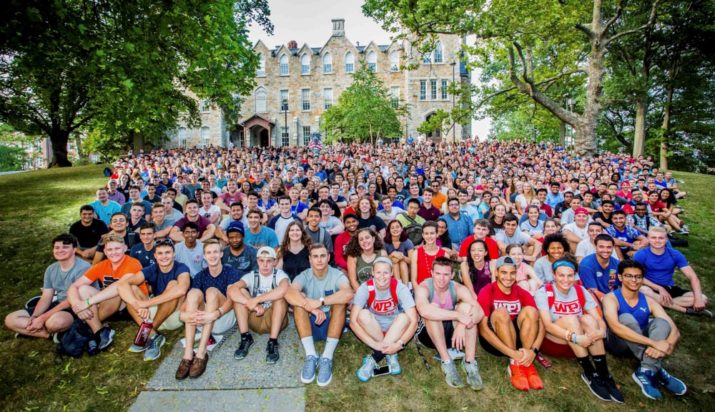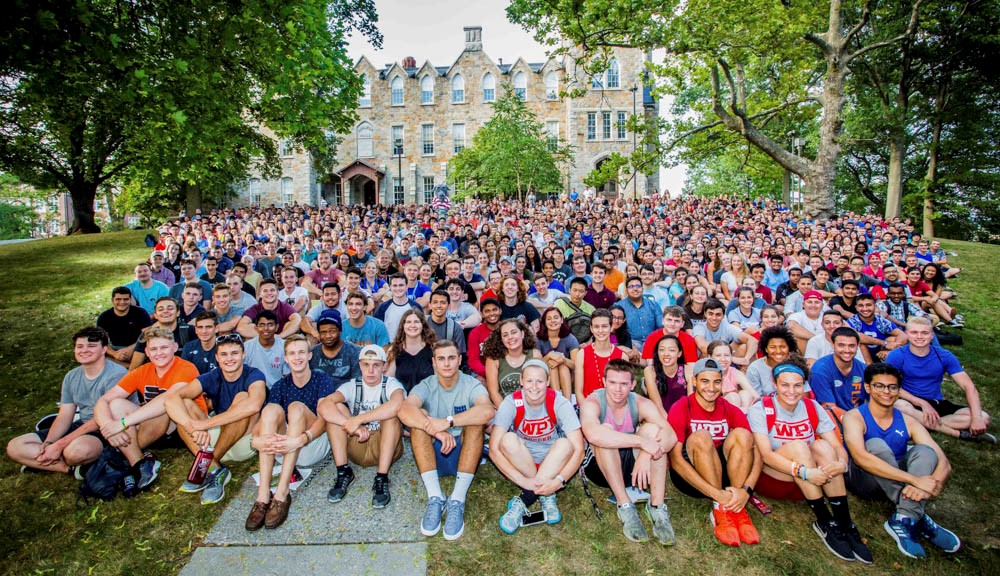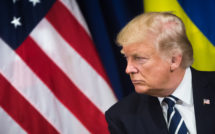

This is part of our special feature, Confronting Waste.
Sponsored Research in the First Year of College
Worcester Polytechnic Institute (WPI) is a recognized innovator in many academic areas. It is a polytechnic with a strong commitment to the arts and humanities. Its extensive global studies are unique and go beyond other colleges’ “exchange” or “study abroad” programs. Most importantly, its trademark project-based learning model permeates all levels and all disciplines of students’ experience. Project-based learning at WPI starts early and in earnest. Incoming students are urged to enroll in the team-taught Great Problem Seminars (GPS) dedicated to broad societal issue (such as Power the World or Heal the World) tackled by a multi-disciplinary team with practical impact in mind. In some of those seminars, students can work on a real-world issue for a real customer. This bold move is risky, time-consuming, and not without opponents even on WPI campus. But does it have merit? Is the pedagogical risk of swinging the academic doors wide open to the world for college freshmen worth the reward reaped? This is an exploration of the challenges and opportunities posed by this educational initiative.
David Siegel’s (2012) article “Beyond the Academic-Corporate Divide” vehemently argues with a strongly held belief that academic engagement with the world of business is “a dirty, unchaste affair” (29). GPS courses at WPI that involve commissioned research by the first-year students have shown that direct engagement with the outside organizations is not only educationally and ethically sound but also offers rich opportunities to communicate across disciplinary and professional divides, to learn with a motivation of a change agent, and to advance quickly as a learner and citizen. To clarify, by “sponsored research” we don’t mean work that is externally funded and contract-bound. Such work could legitimately raise questions about commercial control and the university’s fundamental mission as an intellectually independent body (Bok, 2003; Krimsky, 2003; Washburn, 2006). Our projects are not governed by a contractual relationship with an external agency, but they are proposed by a real company, non-governmental organization (NGO), or university lab to meet a real societal need, as well as the educational objectives of our seminar. “Sponsorship” in our case implies grounding students’ work in the reality of societal problems already under investigation by a company or research organization.
Suggested topics remain fairly open-ended and not subject to strict regulation by sponsors in terms of methods and outcomes. Student teams consult, negotiate, and arrive at a research question with the project sponsor. While they try to address the sponsor’s expressed need, the sponsors allow significant freedom for students to come to their own conclusions in their own way. Performing sponsored research, our students help jump-start a new line of inquiry, contribute to dissertation-related research, perform feasibility studies, or engage in proof-of-concept work. Nonprofits, NGOs, and research labs have been our prime targets for sponsorship of our student projects. Among the sponsors who have commissioned student projects to our program are Fundación Paraguaya, Seven Hills, Museum of Russian Icons, Metal Processing Institute, WPI Center for Resource Recovery and Recycling, Battery Resources, and others.
The inclusion of sponsors into the teaching of Great Problem Seminars at WPI is an optional step for the teaching team. Some seminars don’t offer sponsored topics for their students. Other instructors may have just a single team of students pursuing commissioned work, while still others elect to have all project teams work with sponsors. There is no question that sponsored projects, especially in the first year, require extra effort and time on the part of the teaching team. Instructors need to enlist outside sponsors, help them formulate research question that fits the timeline and ability of the researchers. They have to establish the pattern of student–sponsor interactions, and help all reach successful outcomes. Students need to learn to communicate across corporate, cultural, and disciplinary differences and to bridge academic and industry agendas. The sponsors have juggle everything from data collection support to protecting private information from undue exposure when they deal with the fist-year students. So, given the extra effort and responsibility for all involved, why do it? The discussion below demonstrates the process as well as key benefits and challenges of the engagement of sponsors in terms of (a) motivation to learn, (b) a communication-intensive experience, (c) cultivating contextual and cultural sensitivity; and (d) fostering personal growth.
Motivation to Learn
The overarching mission of any educational initiative is to create a motivating learning platform. While a pressing societal problem is a huge motivation in itself, sponsored work supercharges it by giving it a human face. World hunger, for example, is a gripping problem, but when you are working on it for a nonprofit that actually helps to feed people in a particular community, you will experience the urgency of coming up with a technology, developing a business plan, and collecting data like you never did in an academic setting before. Students in sponsored projects are motivated to jump right into the issue and learn on their feet. Literature and our experience suggest that “often, a motivated novice will perform at least as well as a bored expert” (Wolfe, 2010). Some of our first-year projects produced patentable work, won poster competitions, got funding, and suggested new avenues for fundamental research. What made these achievements possible was not our students’ precocious brilliance but the motivation they got from working with people who look real problems squarely in the eye.
High expectations and multiple feedback loops (sponsor–advisor–student-end user) create constructive impetus for students to adjust their intervention to the needs of the community and its circumstances. Learning and tweaking continues all the way through testing and implementation, as students’ skills and knowledge get more nuanced and informed by trial and error. Reports on Work Integrated Learning (WIL) experiences by Fleischmann (2015) or Contextual Teaching and Learning (CTL) experiences by Predmore (2005) show a similar surge in motivation and achievement in sponsored situations. The clear sense of why and what for makes it easier for students in sponsored projects to arrive at the how. “They learn more about the engineering process, they experience it firsthand, and show true excitement,” pointed out one of our seasoned project sponsors, referring to how early engagement helps first-year students “reach a successful outcome” in a complex project.
Communication-Intensive Experience
Students in sponsored projects interact not only with their team members and advisors but also with the world outside the university walls. They have to learn the language of corporate or nonprofit cultures to be able to gather data, interview stakeholders, and deliver solutions in a usable format. Their communication goes beyond the academic requirements of writing a project report, or designing a poster. They need to “pitch” the solution in just the right way. Extra layers of communication are added through Skype sessions, phone and personal interviews, as well as collaborative work in labs and offices. This workout in communications is also a leadership workout in which our students evolve into change agents at the implementation stages. Through our sponsored projects, they master the art of stepping from behind their research into the limelight of public debate, policy discussion, and community organizing.
Contextual Sensitivity
Helping solve a real problem for a real organization means addressing differences in language, historical context, corporate culture, and geography. It may also involve understanding different legal, economic, and philosophical frameworks. From the start, our students’ engineering skills develop with sensitivity to end-users. They get to see that the best design is not the one that “fits all” (McDonough & Braungart, 2009) but the one that targets the specific population in a particular circumstance. For example, proposing dehydration as a way to handle the abundance overripe tomatoes at a Food Bank in Paraguay, the students in our project team became aware that they could not talk to their sponsor about dehydrators as commonplace items. While dehydrators are readily available in the United States, they are not standard kitchen equipment in Paraguay. Their sponsored research teaches students the art of quick adaptation to changing conditions and resource limits.
Personal Growth
The self-empowerment students gain through direct involvement with big social concerns is an opportunity to reflect on who they are as people and professionals. Working on issues that have a face helps students connect to themselves. Learning on your feet promotes search for a major, or a path in life leading to personal and professional growth. The experience in such projects proves to be a thrilling induction of students into the wonders of engineering, for example, “This is probably the first time in their careers where they experience what engineering is, and this excites and propels them into their chosen fields.”
Implementation of Sponsored Projects
Our work with sponsors goes through several stages from engagement and cultivation of contacts to project identification and presentation of the results. Each stage of the process offers its opportunities and challenges that are detailed below:
Step 1: Sponsor Engagement
Cultivating a sponsor network takes time and care. Not every organization will be a good fit for participation in our sponsored projects, nor would every institution commit to our particular paradigm. Our criteria for selecting sponsors include openness to support academic processes, interest in fostering students’ emerging skills and abilities as researchers, balancing inspired leadership with desire to guide students through the ups and downs of data collection and analysis. The sponsors commit to giving students regular feedback and to sharing critical data for analysis. While scaffolding students’ efforts, sponsors also need to give them space to draw their own conclusions based on the objective analysis of data collected from various sources.
Working with us, sponsors get coaching experience, and a chance to initiate the new generation into the areas they are passionately pursuing. Seminar instructors offer to stand by and support prospective sponsors in all organizational and academic matters. Our outside sponsors develop a relationship with the campus and feel integrated into its life through attending student presentations, poster sessions, and other campus events of interest to them. During the project, faculty team supports the emerging relationship between the students and the sponsor by attending some Skype and real-time meetings, going on field trips, and modelling to students how to conduct yourself professionally with a sponsoring organization. The right balance needs to be struck between help and helicopter surveillance of the student-sponsor relationships to give each side a chance to own it.
Step 2: Project Definition and Launch
It is essential to set up a productive pattern of engagement with sponsors from the start. This involves starting small and giving the sponsor a chance to test-run the time commitment our projects require as well as our expectations of them. Offering sponsors support throughout the project and building a trusting partnership is essential. Sponsors need to feel part of the teaching team entrusted to guide and inspire the students. At the point of project launch, faculty help is often called to define a suitable research question. The topic first suggested by the sponsor is often too broad and in need of paring down. “How can recycling benefit the poor in Paraguay?” after several brainstorming sessions boils down to a practical “How can the women involved in waste picking in a particular city area be trained for the sorting and disassembly of small electronics so that they could support themselves?” That is a problem which a group of four first-year students could reasonably tackle in seven weeks. Carefully coordinated plans, however, get messy quickly. Both faculty and sponsors need to mitigate frustrations and help students learn to live with uncertainty and changes of direction. Sponsors need to report emerging issues and introduce corrections as they arise in real time and assist students in finding informants who could offer insights and help students forge ahead.
Step 3: Student–Sponsor Communications during Project Development
Once the project is launched and its goals are defined, data collection goes into high gear, and the dialogue between the students and sponsors becomes critical and close. Instructional team helps students manage these contacts by addressing differences between academic and business etiquette, cautioning the students against overblown claims and urging them to discuss with sponsors the right format for delivery of the results. While Skype meetings, stakeholder interviews, and sponsor calls help generate data, teams still face challenges of hard-to-control informational gaps and have to deal with shifting circumstances, cultural differences, and the ever-expanding circles of inquiry. The sponsor’s role at this point is not only to help with contacts but also to remind students to see the big picture despite the missing pieces. Working with sponsors also means learning to attend to the cultural context. There is no point in processing tomatoes into powder, for example, if dry soup packets hold no appeal to local consumers. It is also pointless to collect electronic waste if there are no local companies that can pay for it. This information can come only from communications with people on the ground, and students need to seek it from the right sources. Some of the challenges project teams encounter at this stage include getting overly dependent on the sponsor to the point of abusing the sponsor’s time and resources. Students could also get overanxious about missing data or gaps in communications. All this should be addressed at sponsor-student-faculty weekly meetings.
Step 4: Project Delivery and Assessment
Deliverables in sponsored research take many forms. Though academically required, poster, presentation, and report are often but secondary tools in sponsor’s evaluation of students’ work. Sponsors may prefer to see a marketing plan, a prototype, or a proof-of-concept design. To strike a balance between the academic and nonacademic needs, a team could produce a pamphlet and instructional materials in addition to a poster and report. A business plan proposing a new venture could be added to the required report to meet both the academic requirements and the sponsor’s practical needs. Some guidelines for achieving a satisfactory end point include striking a compromise between the sponsor’s expected format and a course deliverable in early stages of the project. Students may decide to translate their key findings into Spanish or distil key recommendations in a colorful marketing pamphlet. Clear understanding of where the sponsor sees the most value-added will direct the project along constructive lines while keeping an eye on academic assessment criteria as well.
The feedback students receive from their faculty advisors often differs qualitatively from what they hear from sponsors. Faculty advisors pay attention to argument development, research organization, internal logic, and conceptual gaps. They care about the quality of writing and presentation skills. Sponsors are much more concerned with the utility of the results and plausibility of implementation. They also think of how the project recommendations could benefit their search for funding, internal restructuring efforts, or the next phase in product development. Those agendas may have a different timeline, measures of success and audience in mind. It is not by chance that many researchers describe sponsored work in academe as “contextual teaching and learning” (Predmore, 2005). However, the agendas of a nonprofit or a lab need not be in conflict, and the students benefit by learning the art of serving “many masters” early in their careers. Many challenges of coordination and alignment are repaid by the rich harvest of mastering a variety of communication and research tools. An integrative measure of success could register highly motivated progress towards a solution, learning and honing of several valuable skills, critical thinking in the face of uncertainty and the ease of transcending cultural and disciplinary boundaries.
Work on sponsored projects pushes students to draw on deeper resources and demands a higher degree of self-reflection and self-mobilization than traditional learning frameworks. According to Dehler (2006), “This creates a situation whereby students experience the struggle of coping with turmoil, tension, and the social embeddedness of real organizational problems, enhancing their competencies as a result.” P. 660 Such a process, Dehler observed, engages students “in critical reflection to identify, illuminate, and critique your underlying assumptions and how they have, or have not, been affected” (664). Our own experience with sponsored projects in the first year of college shows that ties with the industry or nonprofits do not compromise student learning. On the contrary, they help students define their professional identities sooner, make their personal commitments deeper, and produce a springboard for highly motivated and focused learning. The immediacy of interaction with the real world, the diversity of cultural perspectives, and the urgency of finding solutions create a highly stimulating learning context. Rather than seeing alliances with outside institutions and with industry as “dirty and unchaste” (Siegel, 2012), we experience them in GPS as transformational and productive of quality learning. After almost a decade of engaging sponsors in our seminar, we also see that “corporations are enhancing the learning, not diluting it” (Siegel, 2007, 54). Palpability of the problem cultivates a sense of agency and ownership of learning—the ultimate goal of any educational initiative.
Svetlana Nikitina is an Associate Teaching Professor of English at Worcester Polytechnic Institute offering literature courses in the Humanities and Arts Department. She has been involved (in partnership with Professor of Mechanical Engineering Diran Apelian) in teaching innovative multi-disciplinary project-based Great Problem Seminars (GPS) where all first-year students’ projects are commissioned by outside sponsors.
References
Bok, D. (2003). Universities in the marketplace: The commercialization of higher education. Princeton, NJ: Princeton University Press.
Dehler, G. E. (2006). Using action research to connect practice to learning: A course project for working management students. Journal of Management Education, 30(5), 636–669.
Fleischmann, K. (2015). Developing on-campus work-integrated learning activities: The value of integrating community and industry partners into the creative arts curriculum. Asia-Pacific Journal of Cooperative Education, 16(1), 25–38.
Krimsky, S. (2003). Science in the private interest: Has the lure of profits corrupted biomedical research? Lanham, MD: Rowman & Littlefield.
McDonough, W., & Braungart, M. (2009). Cradle to cradle: Remaking the way we make things. London, UK: Vintage.
Predmore, S. R. (2005). Putting it into context. Techniques: Connecting Education and Careers, 80(1), 22–25.
Siegel, D. J. (2007). Constructive engagement with the corporation. Academe, 93(6), 52–55.
Siegel, D. J. (2012). Beyond the academic-corporate divide. Academe, 98(1), 29–31.
Washburn, J. (2006). University, Inc: The corporate corruption of higher education. New York, NY: Basic Books.
Wolfe, J. (2010). Team writing: A guide to working in groups. Boston, MA: Bedford/St. Martin’s.
Published on May 7, 2019.
Photo: Class of 2021 | Worcester Polytechnic Institute




